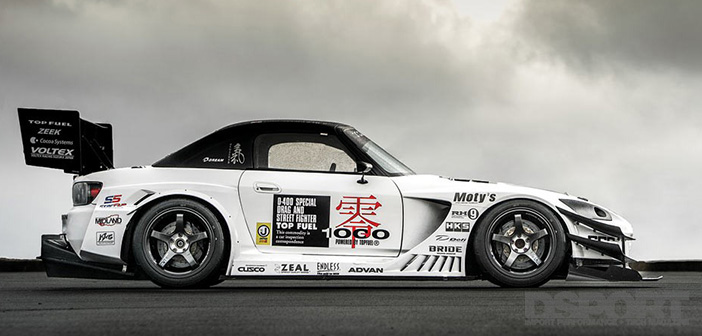An invitation to race in the Pro Class of the World Time Attack Challenge (WTAC) is like qualifying for the Olympics. Only a handful of teams receive an invitation to represent their country, and this fiercely contested class features the quickest time-attack cars in the world. In the first two years of WTAC, Japan’s Cyber EVO and America’s Sierra-Sierra Enterprises dominated the Pro Class, with the Cyber EVO capturing hard-fought, back-to-back wins. But the retirement of the Cyber EVO and the Sierra-Sierra EVO opened the door to new competitors in the field.
Text by Richard Fong // Photos by Rob Shaw, BackFromLeave Photography
Out of Retirement
 The tuning specialists at Top Fuel in Mie prefecture began working on their S2000 time-attack project in 2006. According to Top Fuel’s S2000 project technician, Mr. Morimoto, the project began as a test mule for Top Fuel’s prototype F20C turbo kit. As development of the kit progressed, pitting the AP1 against the clock at Tsukuba became the objective to achieve.
The tuning specialists at Top Fuel in Mie prefecture began working on their S2000 time-attack project in 2006. According to Top Fuel’s S2000 project technician, Mr. Morimoto, the project began as a test mule for Top Fuel’s prototype F20C turbo kit. As development of the kit progressed, pitting the AP1 against the clock at Tsukuba became the objective to achieve.
With horsepower in the neighborhood of 600, a sequential transmission and Top Fuel’s own carbon fiber, wide-body aero kit, the S2000 tipped the scales at just over 2,000 pounds with a weight-to-power ratio of 3.33 pounds per horsepower. This menacing S2000 was dubbed “Type-RR Turbo AP1.” The Type-RR held the RWD lap record at Tsukuba for three years. The economic downturn shifted Top Fuel’s focus and the S2000 took a hiatus from competition. After a three-year break, Top Fuel saw an opportunity to run against the world’s best at WTAC. But to be competitive, Top Fuel would need to take the Type-RR to the next level.
[pullquote]TO BE COMPETITIVE, TOP FUEL WOULD NEED TO TAKE THE TYPE-RR TO THE NEXT LEVEL[/pullquote]
A plan was hatched, a partnership with Voltex Racing was formed and the S2000 would soon be reborn to compete at WTAC. Top-flight aero was a must, and in conjunction with improved suspension and increased power, would prove a potent and competitive cocktail of performance.
Swift in the Wind
 The most obvious change made to the S2000 appears on the exterior. By working with Voltex Racing and its president, Akihiro Nakajima, Top Fuel made a major leap in its quest for quicker laps. Only a few aero kit manufacturers make the effort and investment to evaluate their designs in the wind tunnel, and Voltex Racing is one of them.
The most obvious change made to the S2000 appears on the exterior. By working with Voltex Racing and its president, Akihiro Nakajima, Top Fuel made a major leap in its quest for quicker laps. Only a few aero kit manufacturers make the effort and investment to evaluate their designs in the wind tunnel, and Voltex Racing is one of them.
 Drawing on several years of Formula 1 experience, along with hours spent in the wind tunnel, Nakajima began working on sketches in 2011. He had concept renderings of an AP1 wide-body kit to share in time for the 2012 Tokyo Auto Salon. With only six months before the WTAC event, the Voltex Racing staff went to work, turning the sketches into carbon fiber aero components. After crafting a new front bumper with canards and splitter, wide body fenders, side skirts, rear diffuser and wing, Nakajima and his staff test-fitted the panels. The chassis then made a trip to Mie University’s wind tunnel for testing. Data collected at the wind tunnel dictated adjustments to the design before Nakajima was satisfied. His objective was to maximum downforce with as little additional drag as possible.
Drawing on several years of Formula 1 experience, along with hours spent in the wind tunnel, Nakajima began working on sketches in 2011. He had concept renderings of an AP1 wide-body kit to share in time for the 2012 Tokyo Auto Salon. With only six months before the WTAC event, the Voltex Racing staff went to work, turning the sketches into carbon fiber aero components. After crafting a new front bumper with canards and splitter, wide body fenders, side skirts, rear diffuser and wing, Nakajima and his staff test-fitted the panels. The chassis then made a trip to Mie University’s wind tunnel for testing. Data collected at the wind tunnel dictated adjustments to the design before Nakajima was satisfied. His objective was to maximum downforce with as little additional drag as possible.


